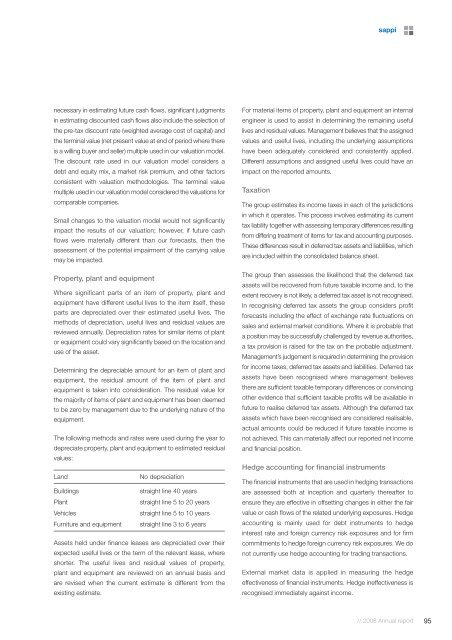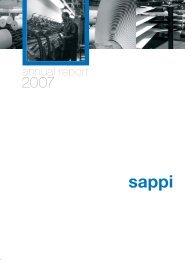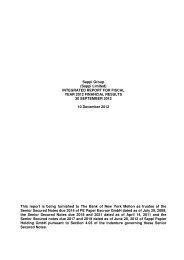2008 Annual report - Sappi
2008 Annual report - Sappi
2008 Annual report - Sappi
Create successful ePaper yourself
Turn your PDF publications into a flip-book with our unique Google optimized e-Paper software.
sappi //<br />
necessary in estimating future cash flows, significant judgments<br />
in estimating discounted cash flows also include the selection of<br />
the pre-tax discount rate (weighted average cost of capital) and<br />
the terminal value (net present value at end of period where there<br />
is a willing buyer and seller) multiple used in our valuation model.<br />
The discount rate used in our valuation model considers a<br />
debt and equity mix, a market risk premium, and other factors<br />
consistent with valuation methodologies. The terminal value<br />
multiple used in our valuation model considered the valuations for<br />
comparable companies.<br />
Small changes to the valuation model would not significantly<br />
impact the results of our valuation; however, if future cash<br />
flows were materially different than our forecasts, then the<br />
assessment of the potential impairment of the carrying value<br />
may be impacted.<br />
Property, plant and equipment<br />
Where significant parts of an item of property, plant and<br />
equipment have different useful lives to the item itself, these<br />
parts are depreciated over their estimated useful lives. The<br />
methods of depreciation, useful lives and residual values are<br />
reviewed annually. Depreciation rates for similar items of plant<br />
or equipment could vary significantly based on the location and<br />
use of the asset.<br />
Determining the depreciable amount for an item of plant and<br />
equipment, the residual amount of the item of plant and<br />
equipment is taken into consideration. The residual value for<br />
the majority of items of plant and equipment has been deemed<br />
to be zero by management due to the underlying nature of the<br />
equipment.<br />
The following methods and rates were used during the year to<br />
depreciate property, plant and equipment to estimated residual<br />
values:<br />
Land<br />
No depreciation<br />
Buildings<br />
straight line 40 years<br />
Plant<br />
straight line 5 to 20 years<br />
Vehicles<br />
straight line 5 to 10 years<br />
Furniture and equipment straight line 3 to 6 years<br />
Assets held under finance leases are depreciated over their<br />
expected useful lives or the term of the relevant lease, where<br />
shorter. The useful lives and residual values of property,<br />
plant and equipment are reviewed on an annual basis and<br />
are revised when the current estimate is different from the<br />
existing estimate.<br />
For material items of property, plant and equipment an internal<br />
engineer is used to assist in determining the remaining useful<br />
lives and residual values. Management believes that the assigned<br />
values and useful lives, including the underlying assumptions<br />
have been adequately considered and consistently applied.<br />
Different assumptions and assigned useful lives could have an<br />
impact on the <strong>report</strong>ed amounts.<br />
Taxation<br />
The group estimates its income taxes in each of the jurisdictions<br />
in which it operates. This process involves estimating its current<br />
tax liability together with assessing temporary differences resulting<br />
from differing treatment of items for tax and accounting purposes.<br />
These differences result in deferred tax assets and liabilities, which<br />
are included within the consolidated balance sheet.<br />
The group then assesses the likelihood that the deferred tax<br />
assets will be recovered from future taxable income and, to the<br />
extent recovery is not likely, a deferred tax asset is not recognised.<br />
In recognising deferred tax assets the group considers profit<br />
forecasts including the effect of exchange rate fluctuations on<br />
sales and external market conditions. Where it is probable that<br />
a position may be successfully challenged by revenue authorities,<br />
a tax provision is raised for the tax on the probable adjustment.<br />
Management’s judgement is required in determining the provision<br />
for income taxes, deferred tax assets and liabilities. Deferred tax<br />
assets have been recognised where management believes<br />
there are sufficient taxable temporary differences or convincing<br />
other evidence that sufficient taxable profits will be available in<br />
future to realise deferred tax assets. Although the deferred tax<br />
assets which have been recognised are considered realisable,<br />
actual amounts could be reduced if future taxable income is<br />
not achieved. This can materially affect our <strong>report</strong>ed net income<br />
and financial position.<br />
Hedge accounting for financial instruments<br />
The financial instruments that are used in hedging transactions<br />
are assessed both at inception and quarterly thereafter to<br />
ensure they are effective in offsetting changes in either the fair<br />
value or cash flows of the related underlying exposures. Hedge<br />
accounting is mainly used for debt instruments to hedge<br />
interest rate and foreign currency risk exposures and for firm<br />
commitments to hedge foreign currency risk exposures. We do<br />
not currently use hedge accounting for trading transactions.<br />
External market data is applied in measuring the hedge<br />
effectiveness of financial instruments. Hedge ineffectiveness is<br />
recognised immediately against income.<br />
// <strong>2008</strong> <strong>Annual</strong> <strong>report</strong><br />
95
















